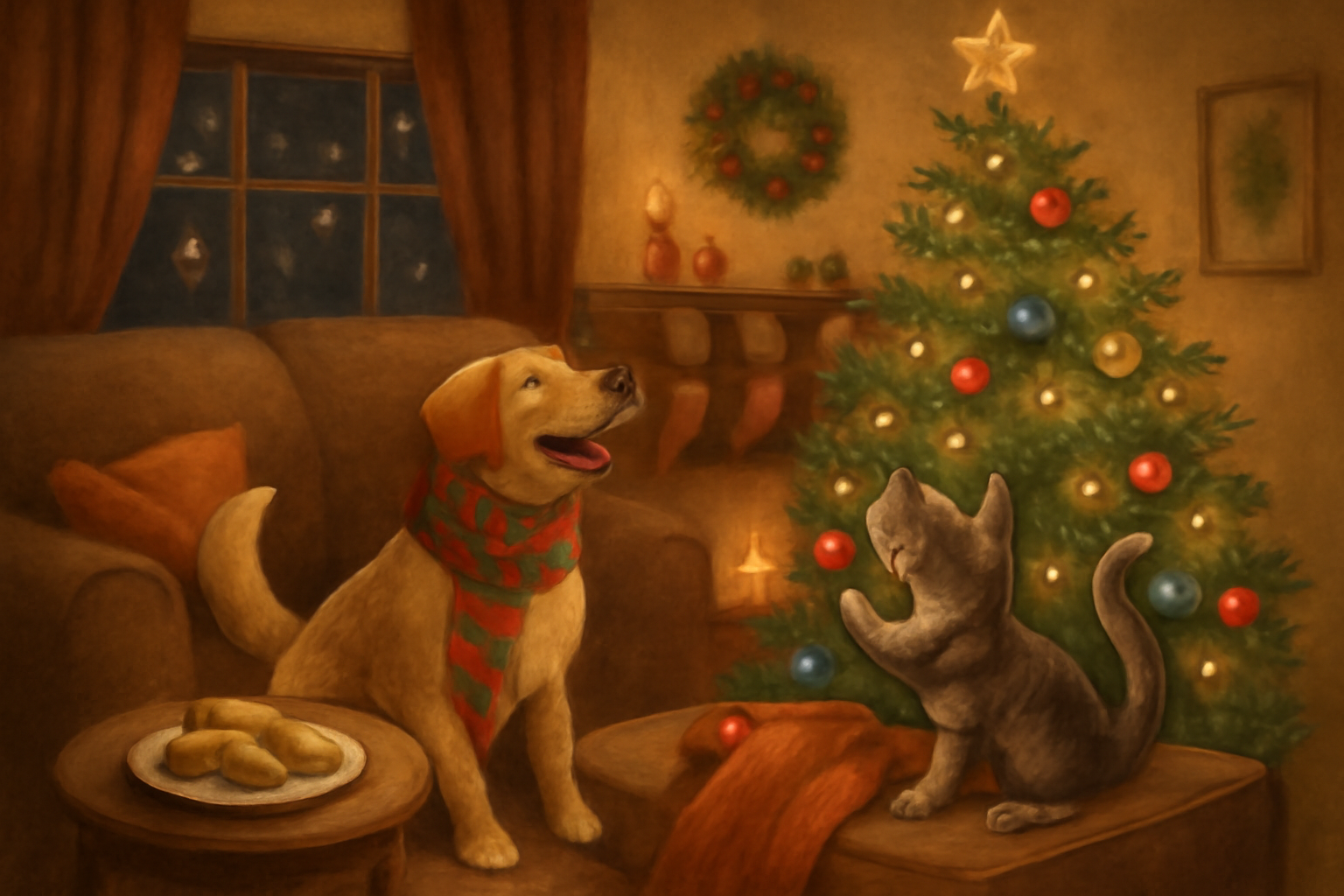The holidays are a time full of joy, laughter, and fun moments, but they can also pose risks to our pets. With all the shiny decorations and delicious treats around, it’s easy to forget that our four-legged friends can get into trouble. If you plan carefully, you can have a lively and safe celebration for everyone, people and pets alike!
Holiday Foods: Treats for Us, Danger for Them!
During the holiday season, food is a big temptation for your pets, who have an incredible sense of smell. But many dishes that we love can be harmful to their health:
What to avoid at all costs:
- Chocolate and Cocoa: Extremely toxic to dogs and cats! Can cause serious heart and nervous system issues.
- Xylitol: A type of sugar found in some candies and gums. For pets, it can cause serious liver damage.
- Grapes and Raisins: Beware! Even a little can cause kidney failure in dogs.
- Onion, Garlic, and Chives: These seasonings can destroy red blood cells in pets, leading to dangerous anemia.
- Cooked Bones: They break easily and can choke your pet or cause serious stomach and intestinal problems.
- Greasy Dishes: Foods high in fat can cause pancreatitis in pets, which is a very painful inflammation.
To ensure food safety:
- Keep an eye out: Never leave food unattended. Use covered trash bins and clean the table quickly after eating.
- Special treats: Instead of giving leftovers, offer treats made just for them. They’ll love it!
Seasonal Decorations and Plants: Beautiful But Dangerous!
Our pets are super curious and can end up knocking over ornaments or chewing on things they shouldn’t. Be careful with these items:
Unsafe decorations:
- Ribbons, Tinsel, and Bows: If they ingest these, it can cause an intestinal blockage.
- Candles: Fire hazard, especially with wagging tails around!
- Exposed Wires: Dangerous for pets that love to chew on everything they see.
Plants of the season:
- Plants like Poinsettias, holly, mistletoe, and some types of lilies can be toxic, especially to cats.
Safety tips for decorations:
- Secure everything: Make sure your Christmas tree is anchored well, avoid real candles, and keep fragile ornaments out of their reach.
Loud Noises and Party Stress: Easing Your Pets’ Anxiety!
The sounds of parties, fireworks, and loud music can stress pets out. Watch for signs like:
- Trembling or hiding.
- Pacing, whining, or barking/meowing excessively.
- Loss of appetite or trying to escape.
How to help an anxious pet:
- Create a peaceful corner: Set up a calm space with their bed, water, and favorite toys. Play soft music to drown out the noise, and consider using calming pheromone diffusers to help them relax.
Home Hazards: Extra Risks During the Holidays!
Keep your home safe by thinking about the additional dangers that come up during the holiday season:
Important safety measures:
- Electricity: Cover wires and store batteries, chargers, and electric decorations out of reach.
- Toxic Cleaning Products: Many cleaning products and air fresheners can be harmful. Store everything safely.
- Small Items: Button batteries and pins, for example, should be kept out of reach to avoid choking hazards.
What to do:
- Review your home: Take a good look around before guests arrive and while decorating.
Travel or Boarding Plans: Comfort and Safety First!
If you’re traveling or need someone to take care of your pet during the holidays, think about their safety and comfort:
Preparations you shouldn’t skip:
- Health check: Ensure vaccinations are up-to-date, and their ID tag is current.
- Home comforts: Bring their bed and favorite toys to make them feel more at ease in a new place.
- Safe transportation: Use proper carriers or safety belts made for pets in the car.
Emergency Preparedness: Acting Quickly is Essential!
Even with all the care in the world, unexpected things can happen. Be ready:
What to include in your emergency kit:
- First Aid Kit: Put together one with gauze, bandages, and antiseptic wipes.
- Veterinary Documents: Keep your pet’s health papers easily accessible.
- Emergency number: Have the number for the ASPCA Poison Control Center (888-426-4435) handy.
Holiday Pet Safety Checklist
Before the party starts, check to ensure everything is in order:
⬜ No holiday food within reach.
⬜ The tree and decorations are secure, with wires hidden.
⬜ No toxic plants nearby; only pet-safe ones.
⬜ A quiet corner prepared for nervous pets.
⬜ Microchip and ID tag updated.
⬜ Travel, boarding, and emergency plans ready.
Celebrate with Care, Less Worry!
With good planning and attention, you can ensure that your year-end celebrations are safe and fun for everyone at home, including your pets. By avoiding temptations, creating a calm environment, and choosing beautiful and safe decorations, you can celebrate stress-free. The best gift you can give your pet during this time is a safe home full of love and care.
